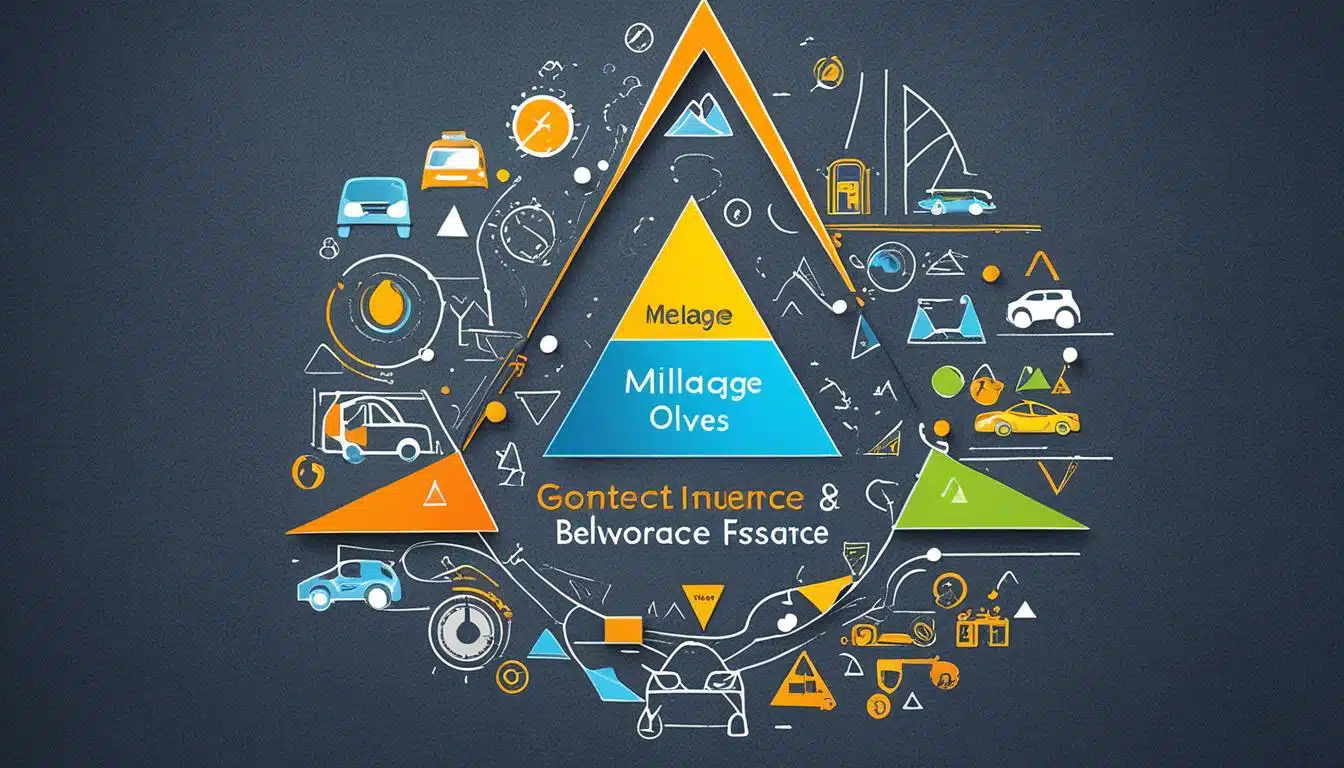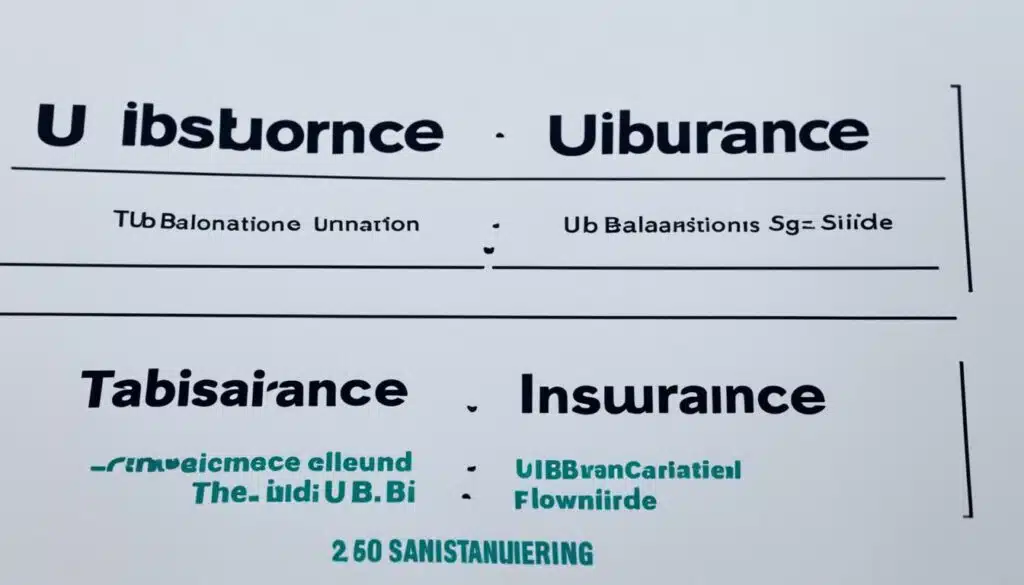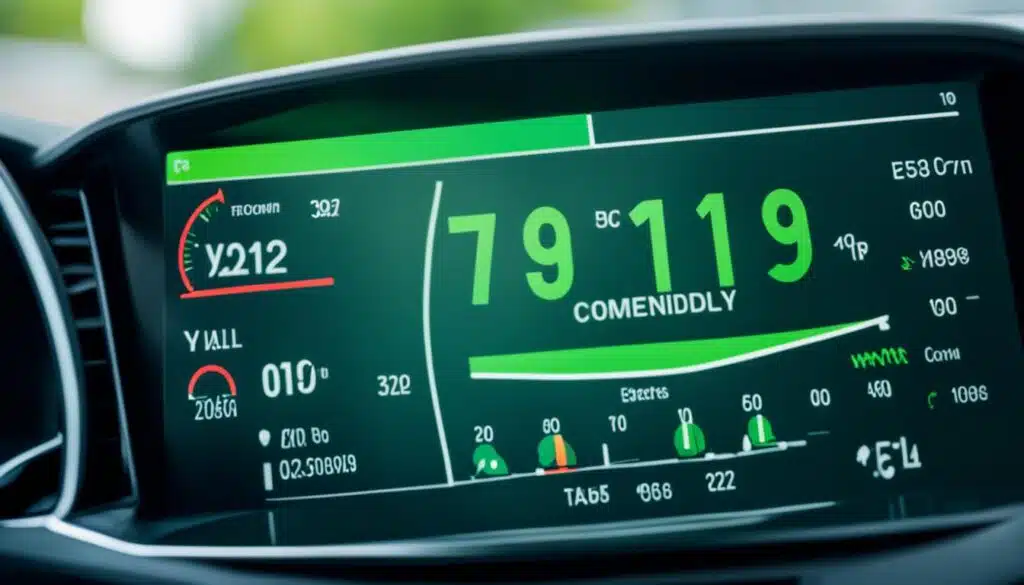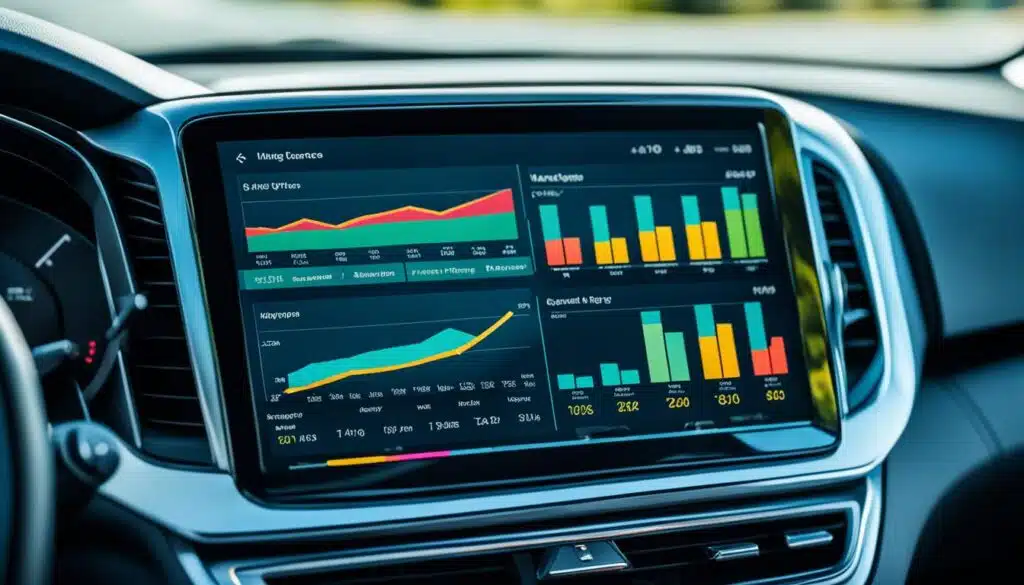Car insurance costs can change a lot from one driver to another. This change depends on how every driver behaves and uses their car. If someone drives a lot every day, their insurance might be more expensive. But, if someone drives less often or drives safely, their insurance could cost much less. This change in insurance costs is what usage-based insurance (UBI) is all about.
UBI is becoming more popular in the world of car insurance. It lets insurance companies give lower prices to customers who drive safely or drive less. This is done by looking at the data collected from devices in cars or from apps on smartphones. This data shows things like the total miles driven, how fast someone drives, and how they brake. It gives insurance companies a clearer picture of how safe each driver is. This allows them to set the right prices for each customer car insurance rates.
Experts in the industry have shared more details about UBI. They’ve discussed different UBI types, like pay-as-you-drive (PAYD) and pay-how-you-drive (PHYD). They’ve also talked about the good and bad sides of UBI when compared to regular insurance. UBI lets drivers help control how much they pay for insurance. It does this by looking at how they actually drive and how much they drive.
Key Takeaways
- Usage-based insurance (UBI) offers a personalized approach to car insurance by basing premiums on actual driving data rather than just historical risk factors.
- UBI can provide discounts and lower monthly costs for drivers who demonstrate safe habits and lower mileage, while potentially increasing rates for high-risk behaviors.
- The two main types of UBI are pay-as-you-drive (PAYD), which focuses on mileage, and pay-how-you-drive (PHYD), which also considers driving behaviors.
- Telematics technology, such as in-vehicle devices or smartphone apps, is the core of UBI, collecting real-time data on factors like speed, acceleration, and braking.
- While UBI offers benefits, there are also concerns around data privacy that insurers and regulators will need to address as adoption increases auto insurance policy.
What is Usage Based Insurance?
Usage-based insurance (UBI) is a kind of car insurance. It calculates premiums based on a vehicle’s usage and how it’s driven. This is instead of just looking at traditional risk factors. UBI uses telematics technology. This tech includes IoT devices in cars. They track things like mileage, speed, and braking. Insurers then adjust your premium based on how you actually drive.
Defining Usage Based Insurance
UBI is different from traditional car insurance. It focuses on how you drive and how much. This helps insurers set prices more accurately. They can give discounts to drivers who drive less or drive safely. UBI comes in two main forms. PAYD uses miles driven. PHYD also checks driving habits like how fast, when you drive, and road conditions.
How UBI Works
To join a UBI program, you need a telematics device in your car or a smartphone app. These track your driving. The data goes to your insurance company. They use it to decide on your premium. Your premium can change depending on how much you drive, the time of day, and the roads you take. This makes your insurance more personalized and flexible than the usual policies.
Telematics Technology in UBI
Telematics tech is essential for UBI. It includes GPS, accelerometers, and more. These are in your car to gather info on your driving and your car’s use. Insurers use this to set your premium more fairly. With this data, they can adjust your premium based on your actual driving habits. This is more modern and fair than just looking at past records.
Also Read : Finding The Right Fit For Your Needs By Understanding Loan Options
Advantages of Usage Based Insurance
Usage-based insurance (UBI) is different from usual car insurance. It offers more flexible and customized premiums. This is a big plus point for many people.
Flexible and Customized Premiums
UBI changes premiums based on how much you drive and how you drive. No need to just look at age or gender. UBI uses real data from telematics or apps to find the best price for you.
Discounts for Safe Driving Habits
UBI programs often cut costs for safe drivers. They check your driving style, not just miles. If you drive safely, your premiums can go down. This puts money back in your pocket.
Lower Deductibles
UBI usually means lower deductibles than regular type of car insurance . Your deductible could be less than you think. This could save you money when you need to make a claim.
UBI helps insurers match your costs with your driving habits. So, if you drive well or not much, it can save you money. It’s a great win for careful drivers.
Also Read : From Shave To Shine: Simplifying Your Daily Men’s Skincare Routine
Traditional Car Insurance vs Usage Based Insurance
Traditional car insurance and usage-based insurance (UBI) both aim to protect drivers. However, they take different approaches on how they price and create policies. This difference shows why people need to think carefully about what they want from their auto insurance.
Comparing the Two Approaches
Traditional car insurance uses fixed risk factors like age and driving history to set prices. These prices generally don’t change much unless you change your policy or driving. On the other hand, UBI changes your prices based on how you actually drive. It looks at things like your speed and how hard you brake using technology in your car or a smartphone app.
Stability of Traditional Insurance
If you drive the same amount all the time, traditional insurance might work better. Your premiums stay the same, giving you a clear idea of what you’ll pay each month. This can be a big plus for those looking for financial predictability.
Flexibility of Usage Based Insurance
UBI, however, offers something different. It adjusts what you pay based on your driving habits. So, if you drive safely or less than most, your bill could go down. This directly links what you pay with how you drive, potentially saving you money.
Also Read : How To Get Financial Well Being To Raise Your Credit Score?
| Comparison Factor | Traditional Car Insurance | Usage Based Insurance (UBI) |
|---|---|---|
| Premium Calculation | Based on static risk factors (age, gender, location, driving history) | Based on real-time driving data (mileage, speed, braking, acceleration) |
| Premium Stability | Relatively stable over time, unless major changes are made | Dynamic and can fluctuate based on driving behavior |
| Personalization | One-size-fits-all approach based on historical risk factors | Highly personalized based on individual driving habits and mileage |
| Potential Savings | Limited discounts based on driving record and vehicle type | Significant discounts for safe driving and low mileage |
The ideal insurance choice varies from person to person. Traditional insurance is great for those with predictable driving habits, while UBI suits those wanting to save through safe driving proof. Your choice depends on what you value more: predictability or flexibility.
Cost Comparison: UBI vs Traditional Insurance
The cost difference between usage-based insurance (UBI) and traditional car insurance varies for each driver. If you drive a lot, traditional insurance might work better. You pay the same even if you drive many miles. However, if you don’t drive a lot, UBI can be cheaper. Your charges are based on how much you actually drive.
Both UBI and traditional insurance can lower costs for safe driving or a clean record. So, the best pick will hinge on your driving ways and the deals each company offers.
Also Read : Your Path To Ageless Beauty Starts Here: Introducing Life Cell Skincare
| Metric | Usage Based Insurance (UBI) | Traditional Car Insurance |
|---|---|---|
| Insurance Premium | Premiums based on actual miles you drive and driving behavior | Premiums based on static risk factors like age, gender, and driving history |
| Discounts | Discounts for safe driving habits and lower mileage | Discounts may be available for good driving record, safety features, or bundling policies |
| Monitoring | Requires telematics device or mobile app to track driving data | No additional monitoring devices required |
| Cost Savings | Potential savings for low-mileage or safer drivers | May be more cost-effective for high-mileage drivers |
In the comparison between UBI and traditional insurance, personal needs matter most. When selecting insurance, be sure to match your driving habits with the best option. It’s the key to finding the most affordable coverage for you.
Data Privacy Concerns with Usage Based Insurance
Usage-based insurance (UBI) is now more common, but many worry about privacy. UBI needs to watch and collect driving habits like where you go, how fast, and how you speed up. This can feel too personal for.
Tracking Driving Data
The devices and apps for UBI give insurance companies a lot of your driving info. This can lead to prices that match you better, plus discounts. But, it brings up worries about how safe and private your details are with insurance providers Consumer Advocacy Recommendations
The Consumer Federation of America (CFA) is a big group for making sure customers are treated right. They say regulators should make sure UBI programs keep your data safe. CFA wants insurance companies to ask you first before using your driving details. They also think insurers shouldn’t sell this info without being clear about it. Without better rules on , and what happens with our info, people are still worried. Fixing these privacy worries is key for UBI to be trusted as it gets more popular.
Also Read : Navigating the world of skincare treatments from facials to peels
Usage Based Insurance: Pay-As-You-Drive (PAYD)
One main kind of usage-based insurance is PAYD. It figures out your insurance cost by how many miles you’ve driven. Insurers can set a more exact price for the risk. If you drive less, you could also get a discount. The key is that you’re being charged for the miles you actually use.
Calculating Premiums Based on Mileage
PAYD works in different ways, as explained by one source. For example, it might use the car’s odometer, GPS data, or a special module. This module tracks the miles and sends that info. Another source adds that PAYD could look at speed, when you drive, and how safe the roads are to make prices even more fair.
Different Types of PAYD
PAYD has many different forms, say the experts. Each type measures your driving a bit differently. This variety lets insurance companies pick the PAYD model that fits their drivers best.
Pay-How-You-Drive (PHYD) Insurance
PHYD insurance goes beyond just checking how far you drive. It looks at how you drive. This involves high-tech tools like sensors and accelerometers. They record things like how fast you go, how hard you brake, and other driving habits.
Monitoring Driving Behavior
This detailed driving data helps insurance companies better understand a driver’s risk. Safe drivers get rewarded with lower premiums. This isn’t just about how much you drive but how you drive, making the pricing fairer for usage-based insurance worth everyone.
Potential Benefits of PHYD
PHYD insurance offers win-win situations. Safe drivers are charged less while those who drive riskier pay more. This makes insurance rates more fair for all. There’s also the chance for insurance companies to improve how they set prices thanks to the data they collect telematics data.
This data may lead to better national association of insurance options that are more accurate. So, it’s a good thing for everyone on the road.
Adoption and Future of Usage Based Insurance
The auto insurance field is changing fast. More companies are offering usage-based car insurance. Still, where you live and who you’re insured with affects if you can get it or not.
Current State of UBI Offerings
Some car insurance companies are welcoming UBI. They use telematics technology to check how safely you drive. This way, they can offer you a fairer price based on how you actually drive.
Yet, not all companies are eager to jump in. The Second source explains there are still some issues. These include privacy concerns and the need for clearer rules on how your data is used.
Challenges and Opportunities
The Third source talks about cool new tech. They mention using your phone to measure how you drive. They think combining this with other smart car technology could make usage-based insurance could insurance the norm.
But, for this to work well, they have to get a few things right. People need to trust that their data is safe. They also want to know the prices they get are fair and make sense.
So, the future of usage-based insurance looks bright. If companies can find the perfect mix of saving you money and keeping everything open, it could become very popular.
Also Read : Choosing The Right Fit: A Guide To Health Insurance Plans
Is Usage Based Insurance Right for You?
Are you looking for a more personalized car insurance pricing? Usage-based insurance (UBI) might be what you need. It considers your driving habits and specific needs. You should think about how much you drive and where, to see if UBI could save you money.
Evaluating Your Driving Habits
To see if UBI is right for you, look closely at how you drive. It’s important to consider things like your daily mileage, the roads you use, and when you drive. If you drive a lot or do risky things like hard braking or rapid acceleration, UBI might not save you much.
Think about how UBI could change the way you drive. It might encourage safer habits, potentially lowering your car insurance premiums in the long run. For some, this is a big plus of UBI.
Consulting with Insurance Providers
After assessing your habits, talk to insurance providers about their UBI options. You’ll learn how the telematics devices or mobile apps work, and how they affect your insurance rate. Take this chance to ask about discounts and how UBI compares to regular insurance.
Ask about UBI’s potential cost savings and if you can adjust your coverage. By chatting with your insurance agent, you can better decide if UBI is a good fit. They can help you understand if UBI meets your driving and financial needs.
Conclusion
Usage-based insurance (UBI) offers a fresh way on car insurance. It looks at how you drive and the miles you cover. This creates a more personal insurance plan. It includes unique premium options, rewards for safe driving, and lower costs to start a claim.
Data privacy is a big worry with UBI. It tracks many details about your driving. Insurers say this lets them reward people who drive safely. But some groups want clearer rules on using this data.
The challenge with UBI is finding a good balance. We need to balance making insurance personal with respecting privacy. It’s key for insurers, lawmakers, and people to work together. This ensures UBI helps drivers and protects their privacy and rights.
FAQs
Q: What is usage-based insurance?
A: Usage-based insurance (UBI) is a type of auto insurance program where your premiums are determined by monitoring your driving behavior, such as time of day, safe driving habits, and the number of miles you drive.
Q: How does usage-based insurance work?
A: Usage-based insurance works by using telematics technology to monitor your driving behaviors. The data collected is used to calculate your insurance premiums based on how safe of a driver you are and how many miles you drive.
Q: Is usage-based insurance right for me?
A: Usage-based insurance may be beneficial for drivers who are safe behind the wheel and don’t drive many miles. It can help you save on insurance costs if you are a low-risk driver.
Q: How does pay-per-mile insurance differ from traditional auto insurance?
A: Pay-per-mile insurance is a type of usage-based insurance where you pay premiums based on how many miles you drive. Traditional auto insurance typically charges a flat rate regardless of how much you drive.
Q: Which insurance companies offer usage-based insurance?
A: Many insurance companies, such as State Farm and other major insurers, offer usage-based insurance programs that use telematics technology to monitor your driving habits and determine your premiums.
Q: What factors affect the cost of usage-based insurance?
A: The cost of usage-based insurance is influenced by factors such as your driving behavior, the type of car you drive, how many miles you drive, and the coverage options included in your policy.
Q: How do usage-based insurance programs collect data?
A: Usage-based insurance programs collect data through telematics devices that plug into your car’s onboard diagnostics port. These devices track various aspects of your driving behavior, such as speed, acceleration, and braking patterns.












